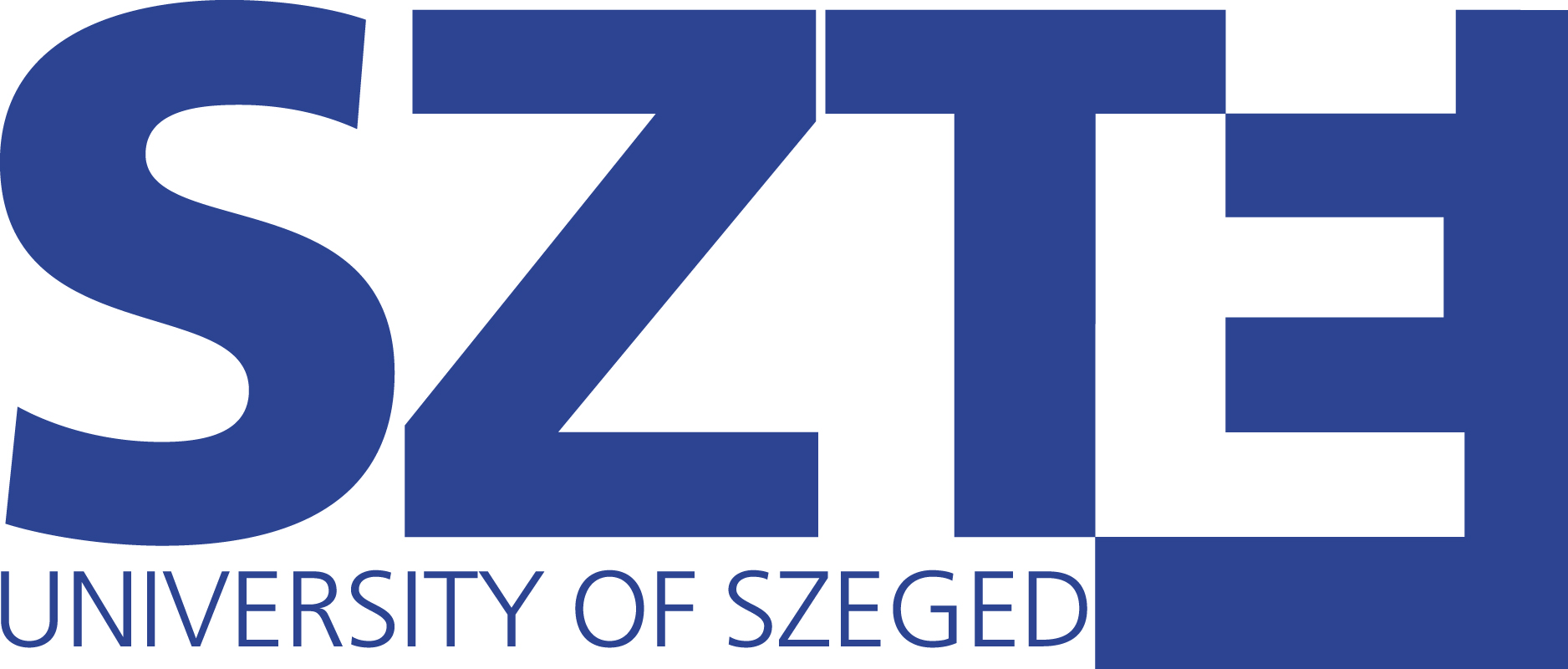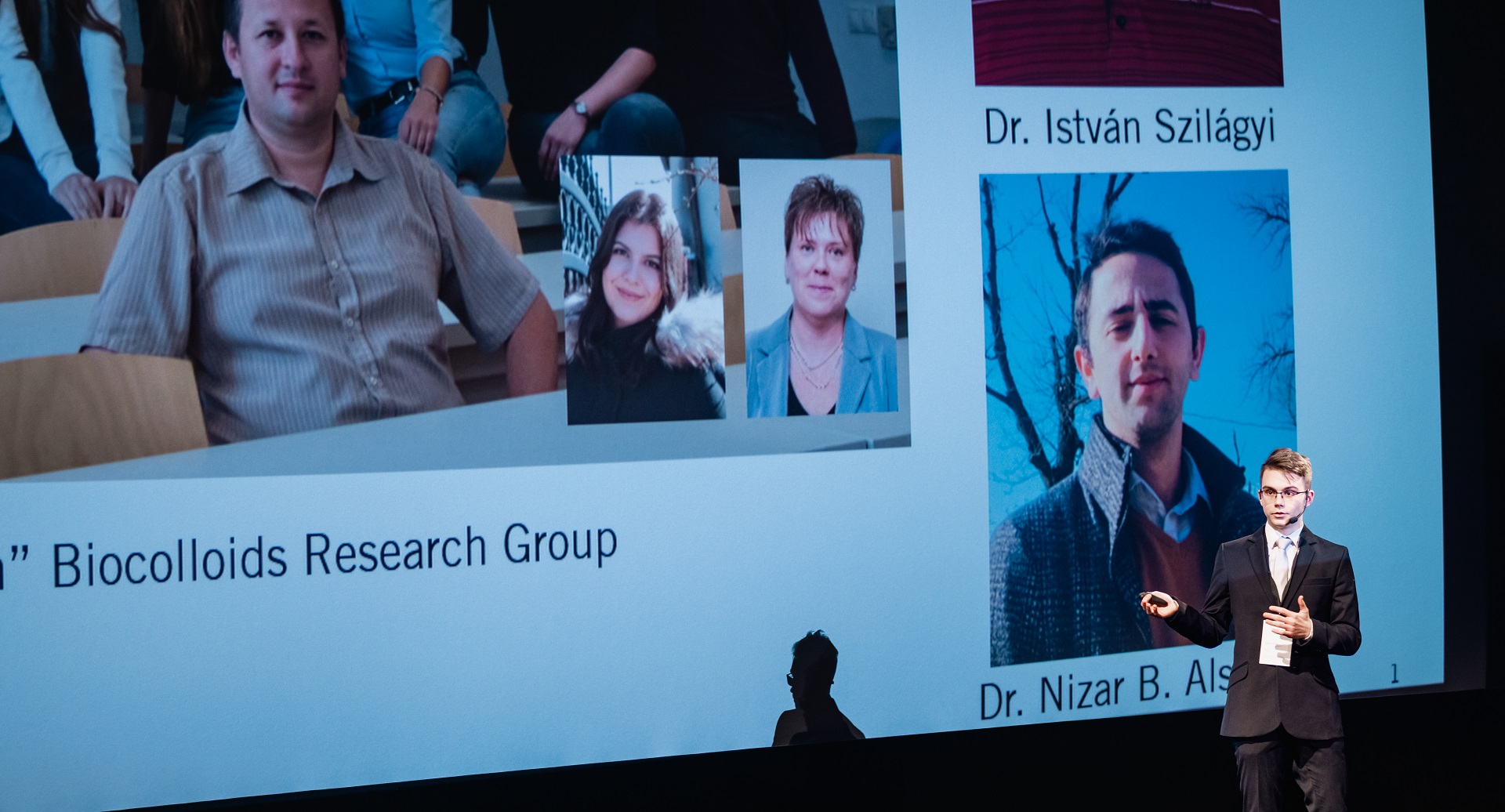
Dániel Viczián not only partied in a tailcoat at the Nobel Prize ceremony but also gave a presentation on the fascinating world of chemistry as a speaker at the "Stockholm International Youth Science Seminar". The first-year chemistry student of the University of Szeged won the right in a competition to represent Hungary as the only young person to participate in the most prestigious programs of the Nobel Week in Sweden. In addition to nanocomposites, we asked Dániel Viczián about his experiences at the Nobel Prize ceremony.
Dániel Viczián, a first-year university student at SZTE, was an active participant in the programs of the 2023 Nobel Week in Stockholm. The "Stockholm International Youth Science Seminar" was part of the series of events of the Nobel Week in Sweden, where the budding scientist from Szeged popularized the science of chemistry.
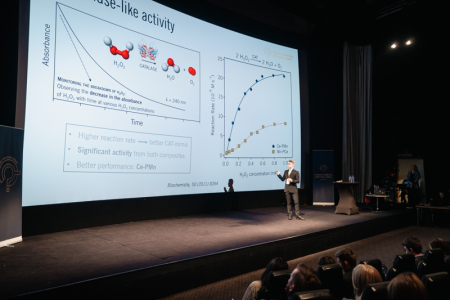 Dániel Viczián presented research results to which he himself contributed, as he joined the work of the MTA-SZTE "Lendület" Biocolloids Research Group of the University of Szeged. Photo: István Sahin-Tóth
Dániel Viczián presented research results to which he himself contributed, as he joined the work of the MTA-SZTE "Lendület" Biocolloids Research Group of the University of Szeged. Photo: István Sahin-Tóth
Szeged success on the SIYSS stage
Since 2001, the Hungarian Association for Innovation (MISZ) has been able to delegate a young Hungarian researcher every year to the Nobel Prize ceremony and the preceding one-week scientific forum in Stockholm. Dániel Viczián won the opportunity to participate in the Nobel Week in the Association's 2023 application. The Szeged University student is a "trained competitor" since he won numerous Hungarian and international academic competitions even in high school. Most recently, as the third prize winner of the 32nd National Science and Innovation Olympiad, he drew attention to himself by presenting research results to which he contributed as a high school student, as he joined the work of the MTA-SZTE "Lendület" Biocolloids Research Group of the University of Szeged.
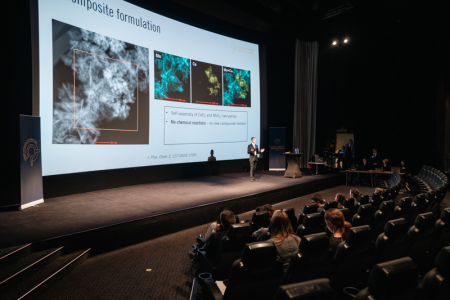 "At the heart of our work is the development of multi-component materials - composites - with enzyme-like activity", began the SZTE student, who represented Hungary on the SIYSS stage alone, his presentation at the Nobel Week in Stockholm.
"At the heart of our work is the development of multi-component materials - composites - with enzyme-like activity", began the SZTE student, who represented Hungary on the SIYSS stage alone, his presentation at the Nobel Week in Stockholm.
"Specifically, we used manganese(IV) oxide (MnO2) and cerium(IV) oxide (CeO2) nanoparticles, which are known to mimic several antioxidant enzymes, such as catalase and superoxide dismutase," the young researcher-student of SZTE recommended his topic to the attention of interested parties on the SIYSS website.
 "Young minds discovering how the world works are truly inspiring. SIYSS gives me hope!" - said the presenter of the Stockholm International Youth Science Forum. Photo: István Sahin-Tóth
"Young minds discovering how the world works are truly inspiring. SIYSS gives me hope!" - said the presenter of the Stockholm International Youth Science Forum. Photo: István Sahin-Tóth
A maximum of 25 from different countries around the world can qualify. 18 young researchers from 13 countries took part in the event between December 4 and 11, 2023.
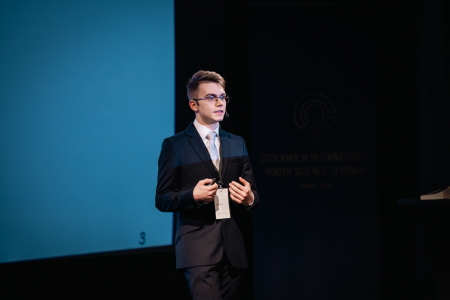
Dániel Viczián received great applause on the stage of the 42nd "Stockholm International Youth Science Seminar", i.e. SIYSS, with his presentation entitled "Multifunctional nanocomposites: synthesis and investigation of their antioxidant effect in colloidal systems". The university student gave his presentation about the MTA-SZTE "Lendület" Biocolloid Research Group and his own research results with great confidence in the Filmstaden Sergel cinema center in Stockholm. He illustrated his presentation in English with an excellent slide show.
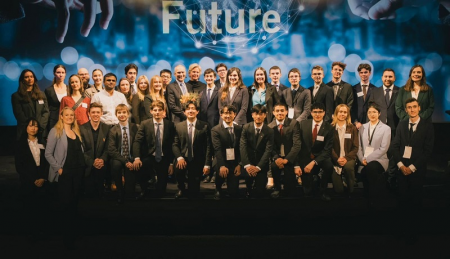 18 young researchers from 13 countries participated in the Stockholm International Youth Science Seminar. Volunteers and mentors helped organize and implement the programs. Photo: SIYSS
18 young researchers from 13 countries participated in the Stockholm International Youth Science Seminar. Volunteers and mentors helped organize and implement the programs. Photo: SIYSS
A test of scientific genres
- You are 18 years old, but you have already given 7-8 presentations on scientific topics. What is special about SIYSS? - we asked the young scientist after the program in Stockholm.
- Until now, I have participated in competitions where I spoke to expert judges about the project to get a good evaluation. Now I had to appear in front of high school students, I had to address them. The goal was for the students to be inspired and get something from the SIYSS program, even if they do not fully understand the details of the scientific topic - he explained.
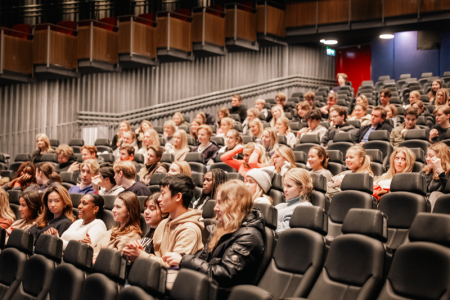
In the big hall of Filmstaden Sergel, Stockholm's cinema center, high school students watched the educational SIYSS lectures, tailored to 7 minutes each. Photo: István Sahin-Tóth
– After your seven-minute presentation, the other scientific genre, the poster presentation, followed. You had to answer the questions of the interested parties for hours while standing in front of the board covering the graphic summary of your presentation. Did you reach your goal?
- Absolutely. One of my goals was to be good according to my inner jury. So I felt good about the performance from the inside. After the poster presentation, I received a much more active line of questions than expected.
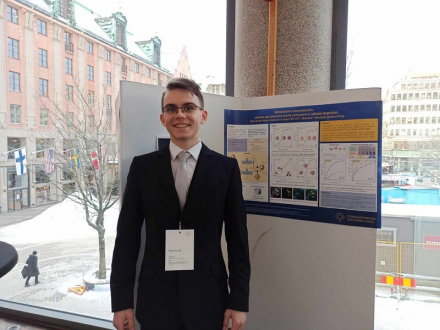 At the poster presentation following the lecture, Dániel Viczián, a chemistry student at SZTE, answered questions for hours. Photo: SIYSS
At the poster presentation following the lecture, Dániel Viczián, a chemistry student at SZTE, answered questions for hours. Photo: SIYSS
– "Did you get a memorable question?"
– "From a scientific point of view, I didn't get a question that I didn't expect." The questions were inquisitive. I was surprised by how often I was asked about the practical applicability of the research result. Many people inquired about my personality, and my relationship with science, for example, where did I get inspiration from?
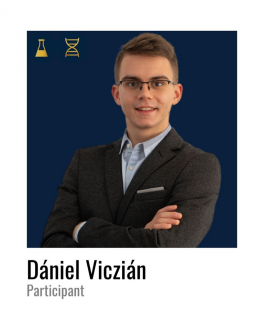
– What was your answer?
– I explained that my topic is a new and actively researched field. Many promising industrial uses are possible. Among these, I singled out the pharmaceutical and food industries. I encouraged students younger than me that if they were interested in any small topic, they should not be afraid to ask. If they are interested in something, if they feel motivated to learn something, that is a very good sign. They should feel free to follow their interests!
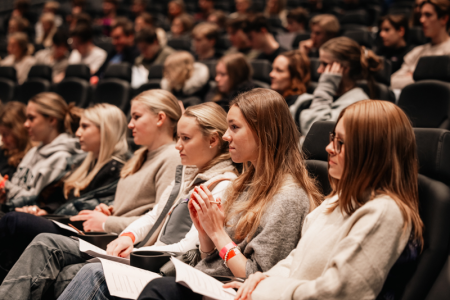
More than 850 high school students participated in the International Youth Science Forum in Stockholm. The presentation of Dániel Viczián and 3 other young speakers on the morning of December 6, 2023, proved that chemistry is not only about test tubes and chemical reactions. Chemistry is the art of understanding matter and its transformations. This field of science offers researchers many exciting topics, from the microcosmic world of molecules to monumental breakthroughs.
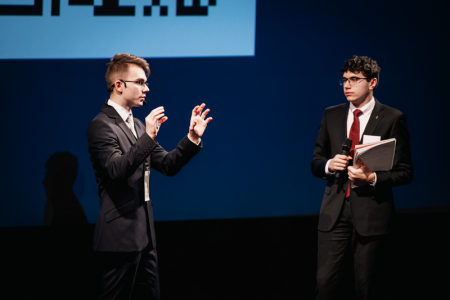
Chemistry is the art of understanding matter and its transformations - as the presentation and answers to questions by Dániel Viczián and three other young people at the scientific forum in Stockholm proved. Photo: István Sahin-Tóth
Hungarians at the award ceremony
In his will, Alfred Nobel listed the science of physics, chemistry, and physiology, followed by literature and the cause of peace as fields worthy of prizes. During the 2023 Nobel Week, the SZTE community paid special attention to the first three of these fields. The reason for this is that the names of three awarded Hungarian researchers, also connected to the University of Szeged, were included in the programs of the Nobel Week in Stockholm.
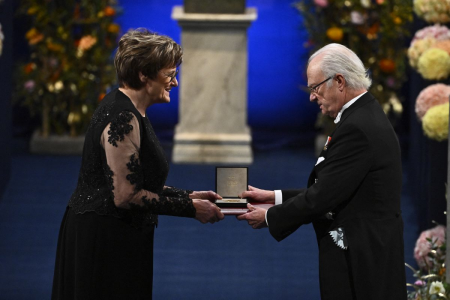 Katalin Karikó, research professor at SZTE, received the Nobel Prize from the King of Sweden, Carl XVI Gustaf. Photo: Europress, AFP, Claudio Bresciani
Katalin Karikó, research professor at SZTE, received the Nobel Prize from the King of Sweden, Carl XVI Gustaf. Photo: Europress, AFP, Claudio Bresciani
Katalin Karikó, a research professor at SZTE, was awarded the Nobel Prize in Physiology or Medicine. She is the first Hungarian woman researcher to receive the award.
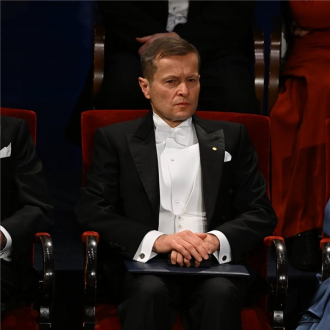 The physics Nobel laureate Ferenc Krausz also owes his award to the experiments he successfully conducted at the ELI-ALPS Laser Research Institute in Szeged. Photo: MTI/Szilárd Koszticsák
The physics Nobel laureate Ferenc Krausz also owes his award to the experiments he successfully conducted at the ELI-ALPS Laser Research Institute in Szeged. Photo: MTI/Szilárd Koszticsák
Ferenc Krausz, a researcher experimenting at the ELI-ALPS research center in Szeged, received the Nobel Prize in Physics.
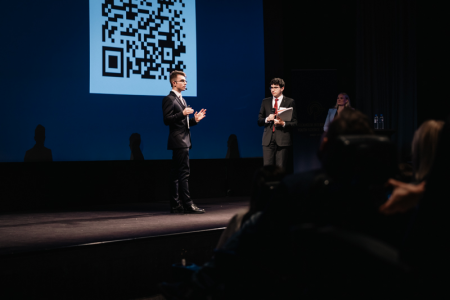
More than 850 high school students participated in the Stockholm International Youth Science Seminar, where SZTE chemistry student Dániel Viczián received huge applause for his presentation. Photo: István Sahin-Tóth
Dániel Viczián, a student of SZTE, was given the opportunity to participate in the programs of the Nobel Week in Stockholm as a star of SIYSS.
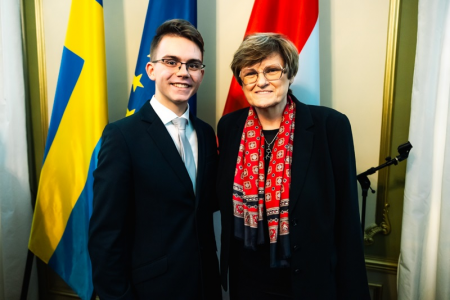 After Szeged, Nobel laureate research professor Katalin Karikó and chemistry student Dániel Viczián, two citizens of SZTE, also met at the Hungarian embassy in Stockholm. Photo by István Sahin-Tóth
After Szeged, Nobel laureate research professor Katalin Karikó and chemistry student Dániel Viczián, two citizens of SZTE, also met at the Hungarian embassy in Stockholm. Photo by István Sahin-Tóth
Dániel Viczián had the opportunity to meet with Nobel laureates, including the two Hungarian laureates, several times. On October 12, 2023, during Katalin Karikó's visit to Szeged, he had the opportunity to meet the Nobel Prize-winning scientist and ask questions as one of the moderators of the student seminar.
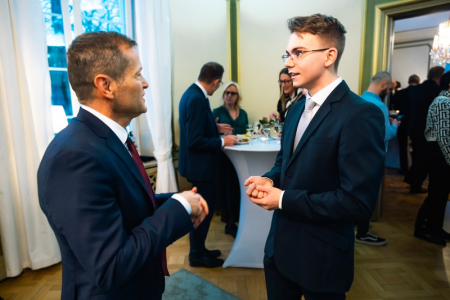
Nobel laureate Ferenc Krausz willingly listened to the SZTE chemistry student Dániel Viczián's research presentation at the Hungarian Embassy in Stockholm, at the reception in honor of the awardees. Photo: István Sahin-Tóth
- The Hungarian Embassy's gala dinner on December 9, 2023, was a memorable program, where I was able to exchange a few words with both Ferenc Krausz and Katalin Karikó - recalled the chemistry student from Szeged enthusiastically.
December 10, 2023, the day of the Nobel Prize awarding ceremony, began with excitement and dressing for Dániel Viczián and the other 17 young scientists of SIYSS.
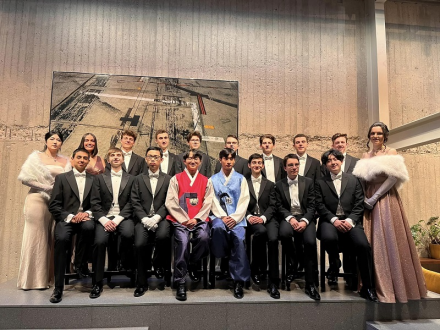
SIYSS's young scientists put on fancy dress and excitedly prepared for the Nobel Prize ceremony. In the photo taken moments before departure, the fourth young man from the right in the standing row is Dániel Viczián, a student at SZTE, representing Hungary. Photo: SIYSS
– We put on our formal attire: the boys wore tailcoats and the girls wore evening gowns. Fortunately, they offered us a rental option in Stockholm, they adjusted the tailcoat for us, and there was also a dress rehearsal. SIYSS organizers took a lot of photos of us in fancy dress, and then we got into a taxi and traveled to the Concert Hall, the location of the Nobel Prize ceremony - he recalled the excitement of the famous day.
"Oh, two Hungarian Nobel laureates?!" - remarked several people when the young scientists were watching the program of the ceremony at the Concert Hall. Some even turned to Dániel Viczián and added: "This must be a really special experience." And they agreed on that.
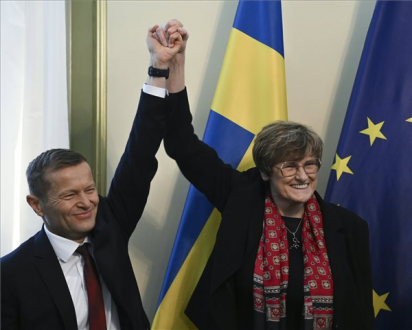 The two Hungarian Nobel laureates, Katalin Karikó and Ferenc Krausz, are also happy about the other's success. Photo: MTI / Szilárd Koszticsák
The two Hungarian Nobel laureates, Katalin Karikó and Ferenc Krausz, are also happy about the other's success. Photo: MTI / Szilárd Koszticsák
- I often got the following questions: "Have you met them?", "How did you get to know them?", "What was it like to talk to them?" I told them what I experienced when Katalin Karikó visited the University of Szeged, where thousands of people could see and experience: she is a very direct person. She is enthusiastic and, in my experience, likes to talk to interested young people. I highlighted that it's definitely worth talking to her a bit. I found Ferenc Krausz to be a surprisingly similar researcher. I met him at the Hungarian embassy in Stockholm. He is a nice, open person. It didn't even look like he was tired of the enormous number of questions and joint photo requests that he had to deal with during Nobel Week in Stockholm.
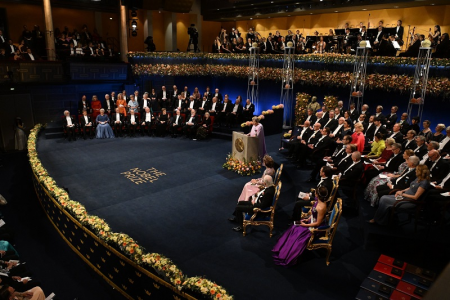 The Nobel Prize ceremony was also the highlight for the participants of the SIYSS event, held between December 4-11, 2023
The Nobel Prize ceremony was also the highlight for the participants of the SIYSS event, held between December 4-11, 2023
Only two SIYSS representatives were seated at the banquet, held at the Blue Hall of the Stockholm City Hall. Most of the young people, including the chemistry student from Szeged, could follow the event on a projector in a smaller room, while the dishes of the gala dinner were also served to them.
- This had the advantage that we could celebrate among ourselves in the freedom of a family dinner - seasoned with lots of laughter and conversation. For example, we could stand up during dinner, which could not have happened in such a formal environment where the King of Sweden and his family are also present - introduced Dániel Viczián to the rules of the Nobel ceremony.
NightCap: sequel to the Nobel banquet
The KTH Royal Institute of Technology said goodbye to the Stockholm Nobel Weeks, that started on October 2, 2023, with a royal party. KTH organized the Students' Nobel NightCap, SNNC event on December 10, 2023, after the Nobel Week Lights open lecture and cultural night. The men are in black and white attire, and the women are in evening dress, yet relaxed: in addition to university students, Nobel laureates, and politicians also appear at the SNNC party, which has been a tradition since 1978.
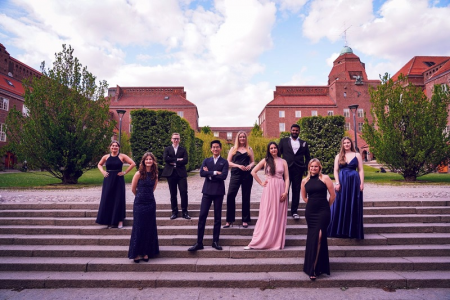 On the night of December 10, 2023, Sweden's largest technical university, KTH Royal Institute of Technology, organized the unmissable event, the Students' Nobel NightCap, SNNC party. Photo: SNNC
On the night of December 10, 2023, Sweden's largest technical university, KTH Royal Institute of Technology, organized the unmissable event, the Students' Nobel NightCap, SNNC party. Photo: SNNC
"The SNNC was the strangest, most unusual event I've ever participated in," said Dániel Viczián. "We stood in line for an hour, a huge crowd wanted to get into the party. "White tie" was the dress code. One of the buildings of the host university, KTH, was enchanted and furnished according to a specific theme. In every room, the visitor found something unusual. All kinds of styles, atmospheres, and drinks were conjured up in the building. All needs were met. Wherever we went, we never knew what - what kind of music and scenery, atmosphere - we would find when we opened the door and entered that room. A very interesting effect was created, for example, by the room where everything flickered while the young people in tailcoats and evening dresses partied. Walking further from there, we reached a calm, pleasant room offering alternative music. At the top of the stairs, in a pink room, a chocolate fountain greeted those entering. The tantalizing smell of barbecue sauce awaited us on the terrace. Another room exuded snow-white elegance with classical music. In another place, there was a theater play, and further on, dancing and a flash mob left me in awe. Where they were partying, there was smoke billowing on the dance floor. Those who visited enough drink counters received a stamp. The owner of the five stamps could visit a secret room. But I haven't been to enough drink counters to tell you about the secrets of that room... For the SIYSS team, partying consisted of conversation and some drinking in a room playing light, upbeat music. A good chat ensued after we went through each room. We got into a taxi at four or five in the morning and headed back to the hotel... We continued to benefit from Alfred Nobel's legacy until December 11, 2023."
Written by: Ilona Újszászi
Translated by: NKI
Photos by: István Sahin-Tóth; MTI /Szilárd Koszticsák;
Europress,AFP, Claudio Bresciani; SIYSS, SNNC
